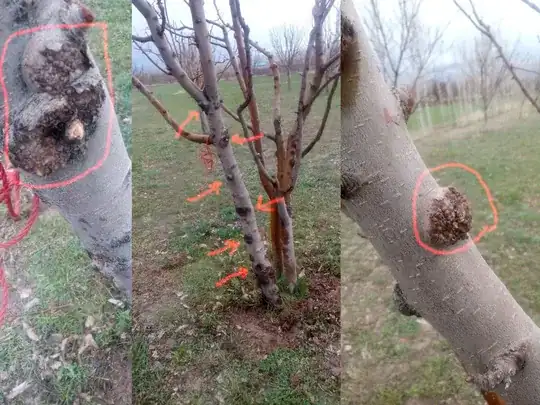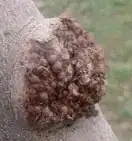I have recently bought an orchard. And one of my trees has these things on its bark. Is these some kind of infection? is it important and what should I do about it?


Asked
Active
Viewed 371 times
1
Mehdi Azizi
- 169
- 6
1 Answers
4
They are called crown galls or burls. The cause is bacteria which have invaded the tree structure, and cause genetic modifications to the tree. The result is that the infected parts of the tree grow in a disorganized way.
They may be harmless, or they may kill the tree completely, depending what parts become infected.
There is no known cure. If you remove the tree and destroy it, the bacteria will remain in the soil for a few years, so don't plant another tree straight away.
alephzero
- 11,339
- 1
- 14
- 22
-
Thanks. I have about 1 hundred trees and just one of them has this infection (I will check again). and you see that this tree has three trunks. only one of them has this infection . Should I remove this tree completely? – Mehdi Azizi Apr 01 '19 at 20:15
-
If you just bought this orchard (as in another question) I would wait and see how well it grows. If it only affects where branches have been pruned off, it might not make any difference to the tree except for that it looks ugly. If the infected trunk isn't growing at all, then get rid of it. – alephzero Apr 01 '19 at 23:29
-
Thanks for your help. To me there is no difference between this trunk and other apple trees in garden. Flower buds and branches all look healthy. So I would leave It for now. – Mehdi Azizi Apr 01 '19 at 23:51
-
There are some varieties that naturally tend to produce these ('Northern Spy', 'Burrknot', 'Arbroath Oslin' and 'Sweet Bough'). They used to be very popular in rural areas as they strike readily from cuttings (the burrs develop roots underground). – George of all trades Apr 02 '19 at 10:10
-
Note that a number of the Malling series of rootstocks readily produce burrs. The image appears to show the three or more stems emerging from the ground. It is likely that some of these are suckers from the rootstock, which may explain the presence of the burrs. Adding weight to this theory is the fact that the part of the tree in the background appears to have a subtly different bark colour - this may be the original tree. Look to see if you can find the graft union, usually around 150mm above the ground level. – George of all trades Apr 02 '19 at 10:11